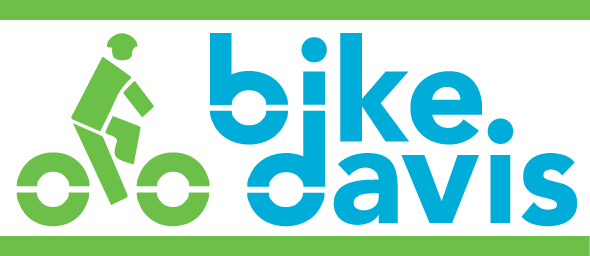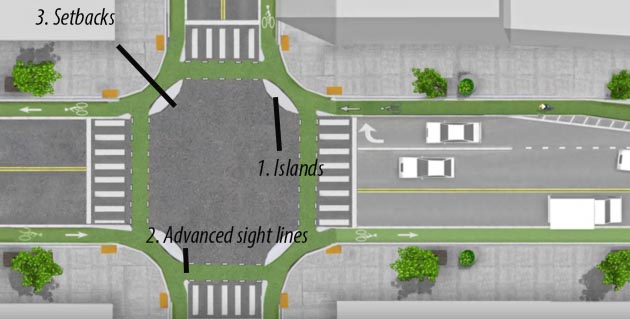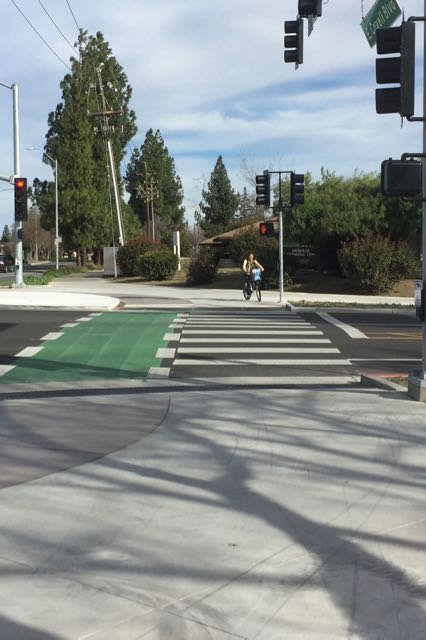Don’t call it Dutch...
Author: Trish Price
February 21, 2016
A couple of weeks ago, a Bike Davis member wrote to the BD board after reading a Davis Enterprise correspondence about our achievements in 2015 from our former president, Mont Hubbard. The member gently pointed out that the historic protected intersection at J and Covell was installed last summer, and wondered why Bike Davis wasn’t more supportive of the new design. After reading through the email conversation, I think our position had been mis-characterized in the media.
Some media outlets reported that Bike Davis actually opposed the protected intersection. While it’s true we preferred a grade separated crossing to a protected, on-street, intersection, this seems to be a fairly obvious preference for an advocacy organization. After all, our mission is to encourage and promote bicycling. Therefore, we advocate for a complete bicycle infrastructure network throughout the city that is safe, comfortable, and convenient for riders of all ages. The safest, and so most comfortable, infrastructure for the “interested but concerned” bicyclist is separated from cars. Advocacy means you have to ask for what you want, not just what you can get.
So, where do we stand on the intersection at Covell and J Street? Let’s step back and take a good look at an idealized “Dutch junction” and compare it to the existing Davis protected intersection, with the intent to improve the design and implementation of the next Davis protected intersection.
What does an ideal “Dutch junction” look like?
Idealized Dutch Junction
The basic feature of these intersections is the presence of four corner refuge islands (#1 in the image), which physically protect bicyclists and pedestrians from right turning motor vehicles. Without these islands, you just can’t call it a protected intersection. Another feature is the advanced sight line created by pushing the bicycle stop line forward of the motor vehicle stop line (#2). This means the motorist doesn’t have to look over the right shoulder to check for bicycles entering the intersection. The final requirement of a protected intersection is that the crossing area for bicycles and pedestrians be set back from the edge of the turn (#3), ideally by at least one car length. This gives motor vehicles time to stop before entering the crossing area. A fourth, generally optional, feature is bicycle specific signal phasing. Please also note that in the idealized intersection above, bicyclists are pushed into the protected areas by default. There is no straight line crossing from a bike lane to a bike lane.
How did Davis do?
Compare the Dutch junction to the image at the top of this article, which shows the Davis protected intersection. [An enlarged copy of the diagram is available, courtesy of the City of Davis.]
Corner islands? Check.
Advanced sight lines? Check, IF the bicyclist uses the refuges. This will mostly only apply to bicyclists using the grade separated path on the south side of Covell. If a bicyclist comes to the intersection in the bike lane, the sight line is even with motor vehicle traffic. There are entry points from the bike lanes to the multi-use trail or sidewalks. However, the on-street markings in the bike lanes tend to encourage the bicyclist to stay in the bike lane (see photo below), rather than guiding them into the protected intersection. The alternative is a tricky 90 degree turn from the bike lane at the crosswalk to get to the protected areas.
Bike lane markings direct bicyclists into unprotected intersection
Similarly, exiting the protected areas into the on-street bike lanes requires a good look over the left shoulder to be sure the lane is clear. In addition, the eastbound curb cut after the intersection is behind two pine trees that obstruct views of bicycles entering the bike lane at that point.
It’s reasonable to assume that most bicyclists crossing Covell will use the protected areas because it’s just a very long crossing. In fact, unless the bicyclist rides into the pedestrian area to push the button to cue the signal (see photo below), even a healthy young adult can’t get across Covell before the lights change if vehicle traffic is light (tried it and couldn’t do it). And, there is no other way for a bicyclist to trip the signal if there is no vehicle traffic. Finally, people with mobility issues, on bikes or on foot, will struggle to make the crossing in time, even with the pedestrian signal, which is currently set at 25 seconds, the minimum required. Median refuges would be a good solution to this problem, of course.
Bicyclist positioned in pedestrian area to push signal button to cross J Street
Finally, the setbacks? While the corner islands are longer than a car length, the radii of the turns are so wide that cars easily navigate these turns at speeds too high to allow for a stop if a bicyclist starts crossing a few seconds after the lights have changed. The southeast corner is the most worrisome, because bicycles may well be coming into the intersection at speed coming off the overpass, and motorists won’t be expecting them.
Based on these observations and hoping to do better on the L Street intersection, Bike Davis recommends that bicyclists should be involved in decisions about marking these intersections. The signal timing has to be generous on this busy corridor, or pedestrian refuges should be installed in the medians. Finally, the motor vehicle turn radii need to be short enough to really slow motor vehicles down as they move around the corners. And, it would be very nice if there were signal phases for bicycles and pedestrians only, with signal cues in the bicycle path.




